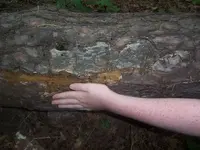The map, drawn by Schultz' bodyguard and entrusted to his buddy, Marty, as "insurance", was reported to have an X drawn on it. Consequently, everyone expected to see an X in real life. Think about that. This site is in a pine grove, between the Esopus Creek and Rt 28, in an area that would not have been disturbed for the length of time Schultz thought he would be in prison. In fact, except for the excavation of the box, the area has not been disturbed. A landmark makes this location easily found, even by a city boy, so a map wouldn't be necessary. The burial hole is equidistant between two pines, so the box could easily be recovered. The southernmost pine, now fallen, was marked with the carving shown above. In spite of the aging of the wood, the hand carving "1934" is still visible. Schultz was indicted in Jan '33 and went on the run, until he surrendered in Nov '34. Since my last visit, someone peeled the bark off this tree. Here my son holds the hanging bark against the trunk, as I attempted to make it appear more as I first found it. This carving was probably made by Schultz, himself, while Lulu dug the hole. Schulz was found not guilty, much to everyone's surprize, but he found himself faced with further charges. So, it is unlikely he recovered the box, until his fate could be determined. The box was to be his salvation, while incarcerated. Schultz refused to comply with the syndicate, and was killed. A rival learned of the map, and shortly after Schultz was shot, obtained the map during a botched hit on Marty. He then claimed that he couldn't understand the map, and gave up after a couple of tries. However, there is a feature, not mentioned above that makes this location easily located. Though not mentioned in the accounts on the map, it probably was, in fact, on the map. Therefore, I conclude that the rival, with the aid of the map, easily obtained the box, getting, not only, a piece of Schultz' former territory, but his personal fortune, as well. He would not have admitted obtaining it, since the gov't was nailing gangsters for criminal tax violations. The Liberty bonds, in the box, were undoubtedly destroyed so they couldn't be traced. As for the $1000 bills, diamonds, and $20 gold coins, they were very liquid, readily accepted in commerce, and could have provided for some lucky TH'er very well.





